Alise Project: Our lithium sulfur cells have reached 0,325 kWh / kg, we are going 0,5 kWh / kg
The Alise Project is a research project funded by the European Union, involving 16 companies and organizations from 5 countries. The scientists simply boasted that they had created a prototype Li-S (lithium-sulphur) cell with an energy density of 0,325 kWh/kg. The best lithium-ion cells currently in use reach up to 0,3 kWh/kg.
Table of contents
- Higher density = greater battery charging range
- Li-S in the car: cheaper, faster, further. But not now
A cell's higher energy density means it can store more energy. More energy per unit mass is either higher ranges of electric vehicles (while maintaining the current battery size), or otherwise current ranges with smaller and lighter batteries... Whatever the path, the situation is always a winner for us.

Battery module with lithium sulfur cells (c) Alise Project
Lithium-sulfur cells are an exceptionally valuable object of study when it comes to the energy density per unit mass of the elements. Lithium and sulfur are light elements, so the element itself is not heavy. The Alise project has been able to achieve 0,325 kWh/kg, about 11 percent more than what China's CATL claims in its state-of-the-art lithium-ion cells:
> CATL boasts of breaking the 0,3 kWh / kg barrier for lithium-ion cells
One of the Alise Project participants, Oxis Energy, had previously promised a density of 0,425 kWh / kg, but in the EU project, scientists decided to lower the density to, among other things, achieve: higher charging power. However, in the end they want to switch to 0,5 kWh / kg (a source).

The battery is based on modules filled with Li-S (c) Alise Project cells.
Li-S in the car: cheaper, faster, further. But not now
Lithium and sulfur-based cells look promising, but enthusiasm is waning for now. They remind you that there is still a long way to go. For example Li-S batteries currently withstand about 100 charge-discharge cycles.while 800-1 cycles are considered a reasonable minimum today, and there are already prototypes promising 000-3 charging cycles:
> Tesla's lab boasts cells that can withstand millions of kilometers [Electrek]
Temperature is also a problem: above 40 degrees Celsius, Li-S cells decompose quickly... The researchers would like to raise this threshold to at least 70 degrees, the temperature that occurs with very fast charging.
However, there is something to fight for, because this type of cell does not need expensive, hard-to-find cobalt, but rather cheap lithium and commonly available sulfur. Especially since the theoretical energy density in sulfur is up to 2,6 kWh/kg – almost ten times that of the best lithium-ion cells introduced today.

Lithium Sulfur Cell (c) Alise Project
This may interest you:

